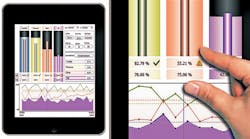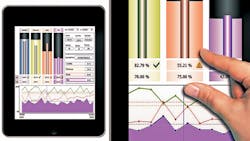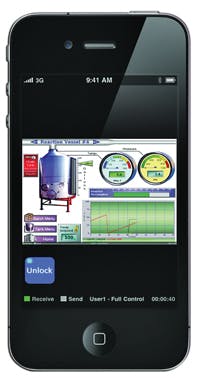If you run a Google search for the phrase “industrial mobile apps” today you will find over a half-million results. So small wonder that the IT market research firm Gartner Inc., Stamford, Conn., recently listed mobile-device diversity and management among its top strategic technology trends for 2014. In fact, four of the top five emerging trends Gartner identified for the coming year relate to mobile apps in industrial settings. Besides mobile-device diversity and management, they include mobile apps for business, the Internet of Everything, and the widespread adoption of smart machines.
It is increasingly common to find engineers monitoring automation equipment or test setups with their smartphones. One trend that is making this kind of advanced connection possible is that of advances in cell-phone infrastructure aimed at factories. For example, cellular routers and modems now support industrial-automation equipment and protocols, even over 4G networks. They facilitate two-way communications from one facility to another and let engineers get information from such remote assets as offshore platforms or far-flung autonomous manufacturing cells.
Until recently, it could be tough to access human-machine interface (HMI) via mobile devices. One of the biggest roadblocks has been in programming: Downloadable apps written for iPhones and iPads won’t run on Androids and tablets, and vice versa. Apps for Apple products must be written in Objective C. Android apps are created using the Java language. Thus, developers have been forced to create separate apps for each family of these mobile devices.
Adding to this complexity is the fact that there are a large number of Android hardware manufacturers. This has created a situation in which the Android market offers six or seven different screen sizes operating from different versions of the Android operating system. Thus, Android apps have had to potentially be developed several times to accommodate the various screen sizes or different versions of the OS.
The result: Developers have tended to devise apps only for one or two platforms, at least initially.
Web browser or app?
Of course, there is an alternative to accessing HMI data with downloadable apps. Instead, it is possible to devise a mobile-enabled Web site that serves as an HMI. Mobile-platform users then connect to the Web site to view automation system data and, in some cases, to issue commands. The advantage of this approach is simpler development: Particularly with the use of the recently standardized HTML5 spec, developers need only create one Web page rather than multiple apps written in Java or C.
The downside is that the quality of the browser-based access experience varies widely depending on the mobile platform. Web-server screens developed on and for PCs don’t scale well to the smaller displays found in handheld devices. Furthermore, the screens, especially the graphics, often take time to load. Another issue is that browser-based remote access often provides only a snapshot of the HMI screens, creating problems when monitoring large amounts of data in operating conditions that change frequently.
It is also easier to create Web pages that provide a read-only view of the data without giving the mobile-device user the ability to issue commands. So developers frequently create Web-page HMIs that are strictly snapshots of equipment status but which provide no way of controlling the process.
On the other hand, downloaded apps for remote access usually provide a smoother interface that is less likely to introduce delays in response. Some developers estimate that use of Web-page access adds about 250 msec of delay, compared to accessing industrial processes through a mobile app and VPN. One reason is that mobile apps for industrial use can be built to incorporate Ethernet/IP and Modbus TCP/IP drivers to let them talk to a PLC on the control system directly.
Making access easier
However, the real benefit of HTML5 support is that more users can access the HMI screens pretty much regardless of the device type. Many features of HTML5 specifically target low-powered devices such as smartphones and tablets. And the browsers on almost all these newer mobile devices all support HTML5. In particular, HTML5 adds new syntactic features for video and audio. There are also features that make it easier for developers to incorporate scalable vector graphics and mathematical equations. The thrust of these improvements is to simplify the task of handling multimedia and graphical content on the Web without having to resort to proprietary plug-ins and APIs.
Though the framework for HTML5 has been around for a few years, its definitions have only recently become stable enough to encourage its widespread adoption. One recent report found that 153 of U. S. Fortune 500 companies have implemented HTML5 on their corporate Web sites.
Like HTML5, multitouch technology has recently become available to the automation world thanks to the arrival of Windows 7, the first Windows-based operating system to support multitouch. While not widely found in HMI packages, multitouch is starting to show up in HMIs that use Windows 7 and Windows 8. However, a point to note is that multitouch is not the same thing as a touchscreen. A traditional touchscreen application recognizes single touches to access specific areas of different screens, basically replacing a pointing device such as a mouse or trackball. A multitouch HMI, on the other hand, works differently. It recognizes the position of several touches and finger movements, which are referred to as “gestures.”
Use of multitouch gestures simplifies the execution of commands, making them up to three times faster than those on traditional touchscreens. These gestures — pinch, zoom, swipe, and so forth — are the same as those used in ordinary smartphones and tablets.
HMI software has also used widgets to provide a graphical representation, such as trend screens, which otherwise can’t be rendered directly on the mobile screen. However, not all HMI software offers a library of widgets for these applications, which makes it difficult or impossible to view certain screens from a handheld device. While the ability to receive alarms on a tablet or phone is not a new development, a widget is often required to view the data graphically. Otherwise, users merely see a text object describing the information.
All in all, PC-based HMI software and operator interface terminals running proprietary HMI software are improving the remote-access experience, but not all such HMI platforms are created equal. Virtually all HMI suppliers now offer remote access, but some do it better than others.
References: AutomationDirect.com | InduSoft


